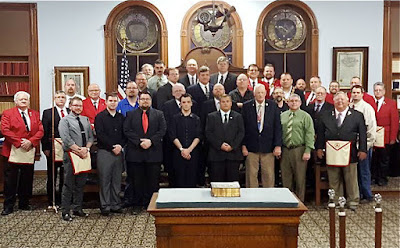Next April will see the ninth annual International Conference on Freemasonry at UCLA, this time with the theme “Hidden Meanings: Esotericism and Masonic Connections.”
The theme is important, because the conference is moving forward without the political content that characterized previous events there, and now is organized under official California Masonic auspices.
From the publicity:
Hidden Meanings: Esotericism
and Masonic Connections
UCLA International Conference
on Freemasonry
Saturday, April 18, 2020
9 a.m. to 5 p.m.
UCLA: 330 De Neve Drive
Covell Commons, Grand Horizon Room
Los Angeles
Freemasonry offers everyone a pathway to self-improvement, fellowship, and community. For the committed few, it holds the promise of even more.
For more than 300 years, Masonic teachings and symbolism have attracted those in search of deeper, secret meanings about the natural and even supernatural world. These esoteric pursuits, shrouded in mystery and mysticism, have endured through the centuries and even today continue to fascinate seekers around the world.
On April 18, 2020, experts and scholars on Freemasonry will meet on the campus of UCLA to discuss the eternal quest for esoteric knowledge and its broader relationship to the craft. The ninth annual UCLA International Conference on Freemasonry is a rare chance for Masons and non-Masons to dive deep on metaphysics, antiquity, and the occult.
Freemasonry and the Esoteric:
Elitism, Insecurity, and
Unenlightened Self-Interest
Ric Berman, author of several books
on Freemasonry, including Espionage, Diplomacy & the Lodge
Although Masonic esotericism hints at ancient secrets, it was in fact not widely introduced into the craft until the 1730s—a means of appealing to an elite aristocratic and mostly French audience. The success of that marriage in the eighteenth century led to Freemasonry’s systematic introduction into the United States, a consequence not of politics or spirituality but economic self-interest.
The Esotericism of the Esoteric
School of Masonic Research
Henrik Bogdan, professor of Religious Studies, University of Gothenburg
The founding of London’s Quatuor Coronati Lodge in 1884 gave birth to a new school of Masonic history and research, based on legitimate texts and study rather than the subjective or “inspired” Masonic writers of the past. However among this new school were a subset of scholars approaching research from what historian R.A. Gilbert called the “Esoteric School of Masonic Research”—part of a broader milieu of fin-de-siecle occultism.
Hidden and Visible:
Mormon Garments in Community
Nancy Ross, assistant professor, Interdisciplinary Arts and Sciences,
Dixie State University
Weighted with meaning, sacred (and secret) undergarments have long been a highly important, though seldom discussed, part of the Mormon church. Indeed, across religions, sacred garments like these have presented profound dilemmas and indicated deeper meanings for wearers and their broader communities.
Freemasonry and Neoplatanism
Jan Snoek, historian of religions,
Institute of Religious Studies,
University of Heidelberg
Several philosophers, expanding on the teachings of Plato, developed theories without which Freemasonry could never have found its form. From Abbot Suger’s construction of the church of St. Denis—Europe’s first gothic cathedral, dedicated to light and beauty—to the third-century parable of the sculptor who must perfect himself, meet the thinkers who paved the way for modern Masonry.
Stephen Freeman
on Antigua and London:
A Respectable Rosicrucian
Susan Mitchell Sommers, professor
of history, Saint Vincent College
The recent discovery of a single surviving pamphlet by a quack doctor, Stephen Freeman, living in Antigua in the late 18th century offers a rare glimpse into not only the thinking of a fringe medical professional, but also paints a stunning portrait of the lives of striving middle-class emigrants in the West Indies struggling for respectability. Largely by leaning on connections through societies including the Freemasons and esoteric Rosicrucians, those like Freeman hoped to improve their lot in society and find deeper meaning—in both cases, often unsuccessfully.
The UCLA International Conference is sponsored by the California Masonic Foundation and the Grand Lodge of California.



















































































